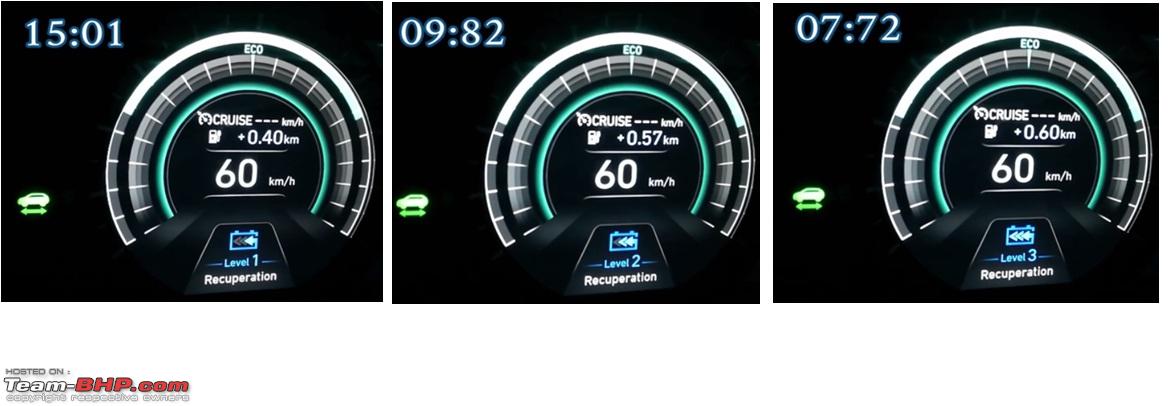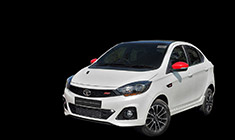News
Extracting the maximum range from your EV: Tips & tricks from owners
Please note that at no point efficiency or range concerns, override road safety.
BHPian EV_Fan recently shared this with other enthusiasts.
Since i am always on a lookout for more means to improve my range(without hypermiling).
So looking for any additional tricks from all the EV owners on the forum.
Some of the quirks I noticed:
1. Regen 1 & Regen 2 are far better than Regen 3 – Regen 1 covers the most distance while Regen 2 recuperates almost the same energy as Regen 3 but covers more distance.
One pedal driving on Regen 3 has given me lower figures than Regen 1 or 2 in the same setting/route.
It also seems to depend on the Driving Mode. I felt the Regen 1 on Sports mode in Kona is far milder than when in ECO mode.
Example-For the same drop of speed from 100 - 60kmph, it shows how much time it took and how much recuperation happened in terms of kms. Regen 1 took 15:01 and gave recuperation of +0.40km. Regen 2 & 3 gave almost same recuperation but different times.

Source
2. Following Eco band or Consumption Indicator on the MID – Almost all EV’s have this in some form or the other and they are quite effective in real time (i think even better than ICE’s fuel efficiency indicators). If you can track & follow these, then great but might need some balancing this with time constraints.
A hypermiling attempt with this made me realize that it can drive up the efficiency to 14-16km/KWh (70-60Wh/km) but can reduce the average speed from 60km/hr by about 10km/hr (i found it nerve-racking to get avg speeds higher than 60 as south kerala just does not have straight, multi lane highways with unidirectional traffic).

Source
3. Driver only mode(love this one on Kona) – choosing the driver only mode on AC like in Kona & Nexon facelift, seems to lower AC load. Went overboard on an attempt to hypermile by setting even the audio system to driver only. Definitely not for audiophiles.
Noticed this on the Kona/Nexon Facelift, although yet to figure how to record or quantify it properly.
4. Scheduling AC at the end of a charging session – If you know you will be done charging and on your way in 30 mins. Then scheduling the AC to cool cabin at that time would utilize the charging session for the cooling. Saves a few watts that might give you a few more km’s. Technically this does not improve efficiency just proxy battery capacity addition Can run the blower on re-circulation for some time, if you had over-cooled the cabin. Yet to exploit this extensively.
5. AC Charging @ lower Amperage – Balances the cells and that in turn seems to provide a better range. I felt the best i have got was when i charged @ 6A or 1.2KW.
Brief about my vehicle & driving style:
Vehicle – Hyundai Kona Electric 39.2KWh variant.
Driving Style – I am quite a defensive driver which helps even in the efficiency department.
Efficiency
- Normal Driving with AC: 10-11km/KWh
- Normal Driving without AC: 12-13km/KWh
- Hypermiling: 14-16km/KWh (Not worth it & not even easily achievable unless its a traffic free road)
Disclaimer: Please note that at no point efficiency or range concerns, overrides road safety. Recommend everyone to do the same. I believe defensive driving makes it stress free for every one.
Here's what BHPian electric_eel had to say on the matter:
You might have already seen my post on the theoretical reason against aggressive regen https://www.team-bhp.com/forum/elect...ml#post5583153 (Aggressive regen can actually reduce an EV's range on the highway | The science behind it)
It also discusses the inefficiency of using cruise control on undulating highways (mostly due to fly overs). I have experienced this quite often in the Thrissur Palakkad section of NH 544. Does that match your experience ?
Here's what BHPian sidoxic had to say on the matter:
In comparison to Kona, the XUV400 is pretty pathetic at efficiency. The best we've achieved is a 140-145 wh/km or 7 km/kWh. These are not hypermilling attempts but just being light footed. But I really doubt going under 125 is possible at all, let alone 100 which you casually achieve! Off topic, i really loved the Kona but had to give it a pass as we are frequently 2+ occupants, but I still think about it every now and then!
Back to topic: this is something I'm very keen on cracking. So thank you so much for your research and list! I've been tracking rides since a few months to find insights for 2 reasons - predictability and extension of extension, both of which are important in sub 350 real world range EVs.
Contributors to efficiency I've noticed
1) outside temperature.
- These are monthly averages for Mumbai City + highways rides, similar routes and same driver.
- April and May: 210 wh/km
- June and July: 160 wh/km
2) number passengers
- This is for a 160km roundtrip we do every week or so
- 2 occupants: 140 wh/km
- 4 occupants: 160 wh/km
Both of these are very EV specific.
The other turbo petrol and turbo diesel in the garage do vary with light and heavy footedness. So not adding those points here. Ford turbo Diesel doesn't care for either of these. Aircon performance impacts the turbo petrol slightly though, but the EV is giving a crazy variance here. Infact Highway vs City gives less % variance in the EV than the ICEs
Unfortunately, unlike your list, there are no work around for my issues! Its not like I'm gonna chuck passangers out on a hot afternoon for sake of range but maybe someday it will make for a good excuse
Here's what BHPian ferrarirules had to say on the matter:
I easily get 120 wh/km from my Nexon EV Max on a regular basis. My usual settings for the drive are
- ECO mode with regen 3 in city and regen 1 on highways.
- AC is set to 26 with auto mode on.
- Tyre pressure is set to 35 psi.
- I don't go beyond 70 kmph in city (where traffic permits), 80 kmph on highways and 90 kmph on expressways (I know 90 kmph for expressways is slow but the lack of chargers on newer expressway pushes you for this).
Other factors -
- Time of travel also makes a big impact on efficiency but that is not specific to EVs. Lower the temperature, less is the load on the AC.
- Season - During extreme summers (temp beyond 40) of north the wh/km jumped to near 140.
- Passenger load - I have not seen a big impact of carrying more passenger in the car. I did a trip from Gurgaon to Sirsa covering 280 kms with 12% SOC remaining. There were 4 adults in the car with boot full of luggage.
- Regen - I let regen do the slowing 99% of the time rarely do i use brake. Regen 3 yields good results for me. One observation - Tata has a brilliant regen implementation if i reduce the regen to 0 and apply brakes for slowing down it still uses regen+brakes to slow down
- Cruise Control - I try and set cruise control where ever possible sometimes slow down or accelerate (when slight slowing or getting back to cruise speed is needed) using the speed setting buttons as well.
Here's what BHPian W.A.G.7 had to say on the matter:
Wow! Those are some amazing inputs, above put there by everyone so far. I didn’t know there would be so many aspects to driving an electric car and maximising the driving range. I also didn’t know we could control the driving style and extract the maximum power and range from the same motor at the same time. Do the same principles apply to electric two wheelers as well? Is there a way to regulate the regen, to maximise the range and power in two wheelers; too?
But… think of it. if I need to do so many calculations for every trip that I do in my electric car/bike, when would I enjoy driving/riding the same? We get a car or a bike because we all like driving/riding. But ev’s involve a certain amount of “prep” work to do before and during the trip. And that’s what I don’t like about electric vehicles: cars in my middle class budget - I need to keep adjusting my driving style to make it to the next goal without getting stranded somewhere in between, whereas those ev’s where I don’t need to worry about my driving range- they are out of my budget!
Read BHPian comments for more insights and information.






_0_0.jpeg)

.jpg)


.jpg)






